
views
- If you have a wire stripper: fit the wire into the matching notch on the jaws of the wire stripper, squeeze the handles together, spin the stripper around the wire, and slide the insulation off.
- If you don't have a wire stripper: slice around the insulation with a utility knife or pair of scissors. Then, slide the loose piece of insulation off the wire.
Using a Manual Wire Stripper

Fit the wire into the notch on the stripper with the matching gauge. Check your wire’s gauge by looking for the American wire gauge (AWG) number on the insulation. Once you find the gauge, locate the corresponding notch along the jaws of your wire strippers and place the wire inside. If you don’t know the wire’s gauge or if your tool isn’t labeled, place the wire in each notch to find where it fits the most snugly. Wire strippers have set gauges they’re compatible with. If none of the notches work for your wire, then use a different stripping method.
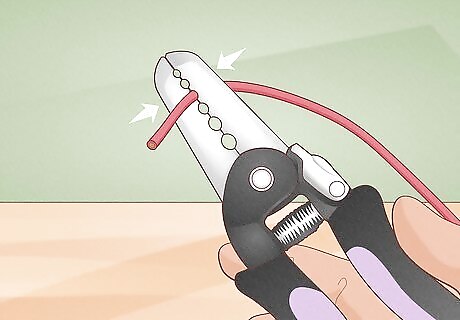
Squeeze the wire stripper’s handles gently. Try to use just enough pressure until you feel the jaws cut into the insulation. Avoid squeezing too hard so don’t damage the wire beneath the insulation, or else it will be unsuitable for an electrical project. If you’re using the notch with the right gauge, the stripper will cut through the insulation without doing any damage to the metal.

Spin the stripper around the wire to fully cut the insulation. After you’ve closed the jaws around the wire, use the wire stripper by carefully rotating the tool around the wire. This ensures the tool has cut through the entire circumference of the insulation.

Slide the stripper off the wire to pull off the insulation. Keep the tool’s jaws closed as you slide it off of the wire to remove the insulation from the tip. Pull the tool toward the short end of the wire to expose the metal conductors underneath the insulation.
Using a Self-Adjusting Wire Stripper
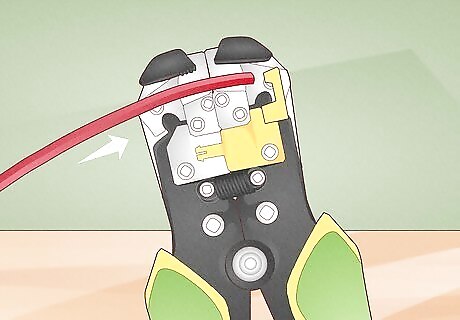
Insert the wire between the jaws of the self-adjusting wire stripper. Self-adjusting wire strippers work with multiple wire gauges without having to change positions or settings. Guide the wire between the jaws at the end of the stripper, starting on the side with the crimped teeth. Position the length of wire you want to strip the insulation on the other side of the teeth. Typically, self-adjusting wire strippers work for wires between 10–24 AWG, but it may vary between tools.

Adjust the length limiter to remove a fixed length of insulation. The length limiter is a plastic piece that stops the end of the wire at a specific length. If you’re stripping wires to connect electronics, set the length limiter down so you don’t accidentally remove too much insulation. Flip the length limiter up and out of the way if you need to strip a longer piece of wire.
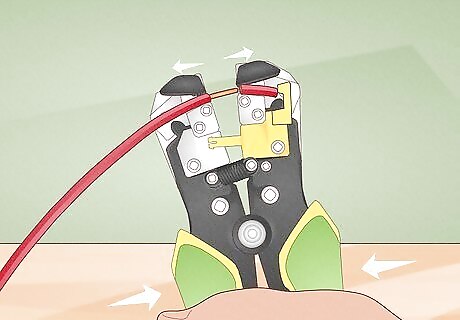
Squeeze the handles together to cut and strip the wire’s insulation. Gently squeeze the handles so the teeth grip onto the wire’s insulation and automatically adjust to the right gauge. Keep bringing the handles together so the blades dig into the insulation and pull it off of the metal wire. Toss the excess insulation in the trash when you’re finished.
Using a Utility Knife
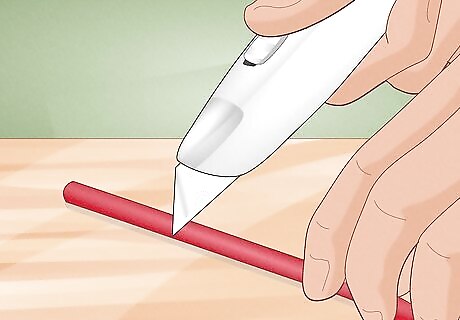
Rest the utility knife’s blade on the wire’s insulation. Place the wire on a flat, sturdy work surface. Use one hand to hold the utility knife against the end of the wire where you want to strip the insulation. Don’t do any cutting just yet, but let the knife rest on the exact spot you want to cut. For most electrical projects, remove 1 inch (2.5 cm) of insulation from the end of the wire.
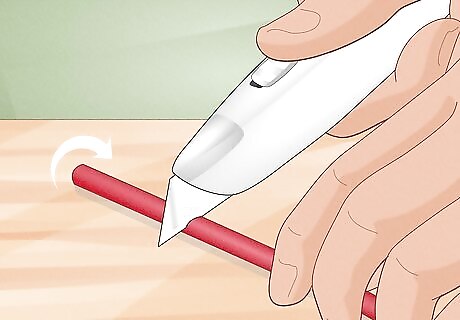
Roll the wire under the blade to score the insulation. Keep holding the knife steady with one hand. With your other hand, spin the wire so the blade cuts into the insulation all the way around and makes a score that’s easier to break. Avoid pressing down too hard with the knife, or you could slice through the insulation and nick the metal conductors. It might take some practice before you can apply the correct amount of pressure, so try out this technique on scrap wires first. If you’re stripping wires to sell the scrap metal, lay the wire flat on your work surface. Slice along the length of the wire with your knife. Because you’re scrapping the metal, it doesn't matter if you accidentally nick or damage it with the knife.
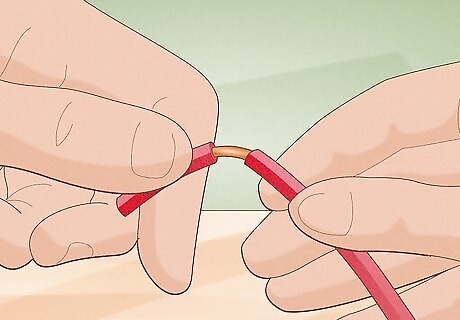
Bend the wire at the scored line to break off the insulation. After scoring all the way around the insulation sheathing, bend the tip of the wire up and down to break through the score completely. Once you’ve broken the insulation at the scored line, slide it off the tip of the wire. Carefully scoring and bending the wire is useful if you want to reuse the wire in an electrical project.
Using Scissors
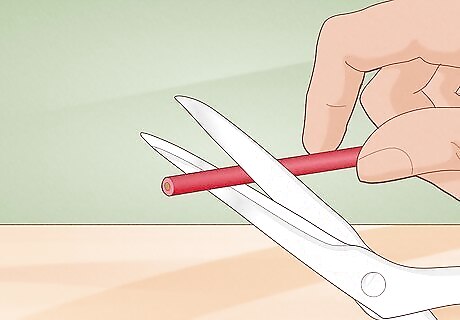
Pinch the wire between the blades of your scissors. Any sharp pair of scissors will work for stripping your wire. Open the scissors and place the wire between the blades. Gently squeeze the handles together so they bite into the wire’s insulation. Electrician’s scissors have built-in notches like wire strippers to remove insulation from your scissors.

Twist the wire to slice through the insulation. While the wire is pinched in the blades, spin the wire between your fingers. Keep squeezing the scissors’ handles so the blades slice through the insulation as you rotate the wire. Avoid squeezing the blades so tight that you cut through the wire or nick the metal inside.
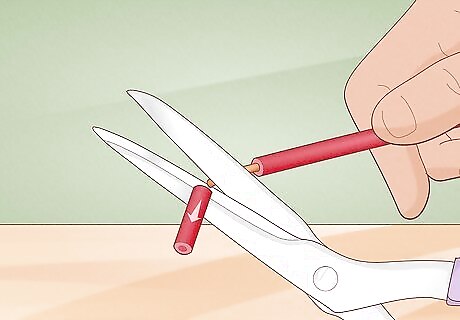
Slide the insulation off the end of the wire. Once you finish slicing through the insulation, it will easily slide off the wire. Hold onto the loose piece of insulation and slide it toward the end to completely remove it from the wire. If the insulation is stuck, keep squeezing the scissors around the wire. Pull the blades toward the end of the wire to help force the insulation off.
Using Lineman’s Pliers

Pinch the wire between the stripping blades on your lineman’s pliers. Lineman’s pliers have blades built into the side of the jaws so you can easily grip and strip wires without switching tools. Open the jaws of your pliers and set the wire near the base between the blades. Gently squeeze the handles together until you feel the pliers dig into the wire’s insulation.
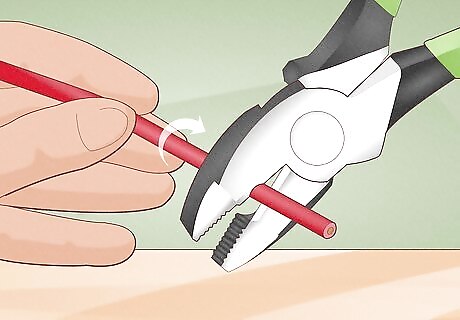
Rotate the pliers around the wire to cut through the insulation. Loosen your grip on the handles slightly so the pliers’ blades aren’t digging as deep into the insulation. Turn the pliers so the blades are on an uncut portion of the wire and gently squeeze the handles together again to make another cut. Continue rotating the pliers until you cut around the insulation completely. Be careful not to squeeze so hard that it digs into the metal, or else you may damage the conductors.
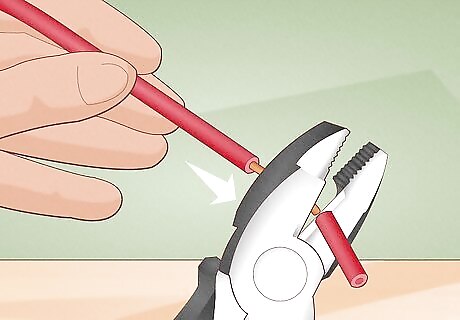
Move the pliers towards the end of the wire to strip the insulation. Hold the wire firmly in one hand, and firmly squeeze the pliers with your other. Pull the pliers toward the end of the wire so the insulation slides off and the metal is exposed. Toss the wire insulation in the trash after you remove it.
Using a Wire Wrap Tool
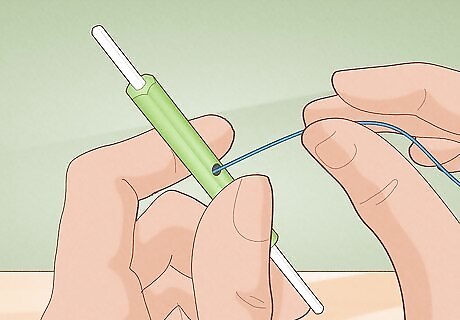
Insert the wire between the wire wrap tool’s blades. Wire wrap tools are normally used to coil wires around electrical components but they also have stripping blades for smaller gauges. Look for the hole with the stripping blades in the middle of the tool’s body. Slide the wire through the main hole until the length you want to strip pokes through the other side. The compatible wire gauges are listed on the side of the wire wrap tool and typically range between 22–30 AWG.
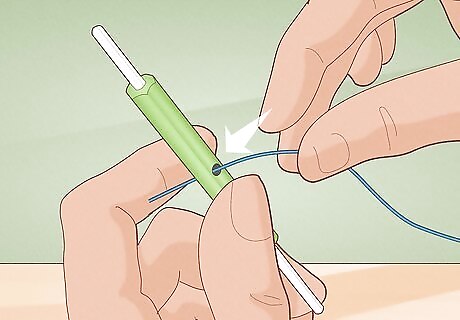
Guide the wire into the slot so it fits snugly. Look for the straight narrow slot on one side of the hole. Hold onto the wire on both sides of the tool and slowly pull it into the slot. The wire will fit snugly in the slot and the blades will cut into the insulation. If the wire easily slides out from the slot, then the wire’s gauge is too small for the blades. Use a wrapping tool that matches the gauge of your wire.
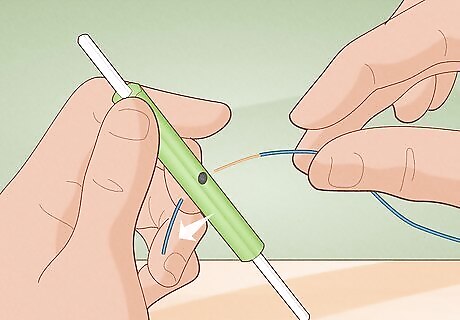
Pull the wire straight out from the tool to remove the insulation. Firmly hold onto the wire with one hand and the wire wrap tool in the other. Simply pull the wire through the slot so the blades cut through the rubber or plastic insulation and strip it off of the metal. If you have trouble stripping the insulation off the wire, try twisting the wire wrap tool around the wire before pulling it.












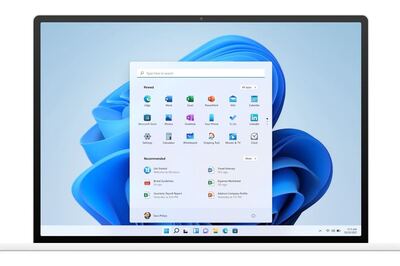



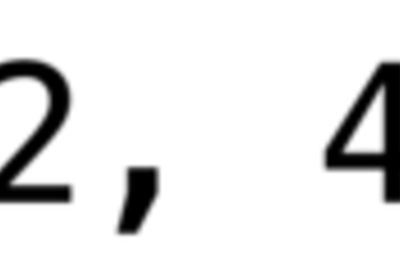



Comments
0 comment